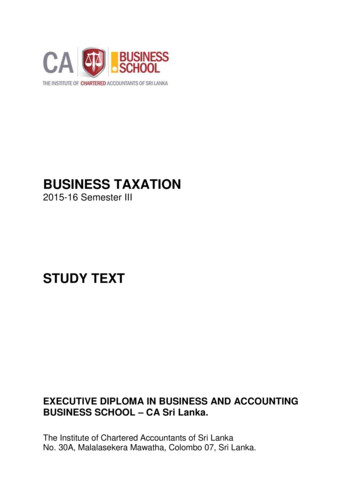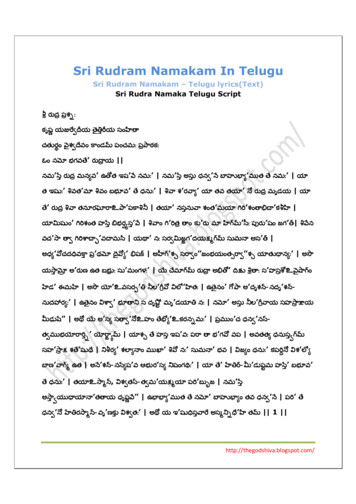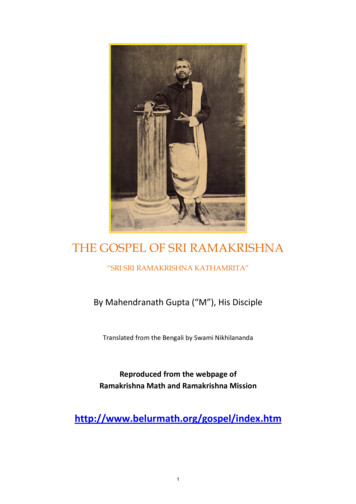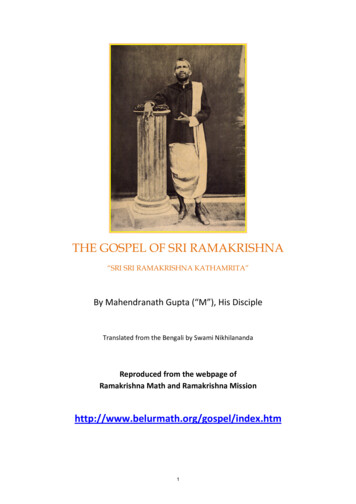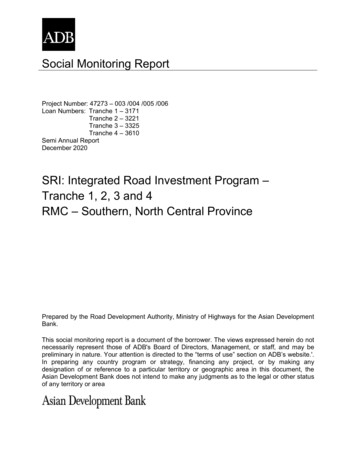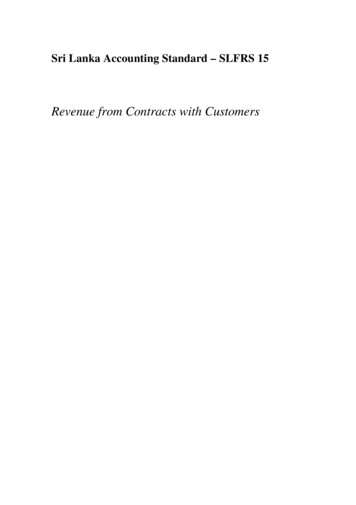
Transcription
Sri Lanka Accounting Standard – SLFRS 15Revenue from Contracts with Customers
CONTENTSparagraphsSRI LANKA ACCOUNTING STANDARD – SLFRS 15REVENUE FROM CONTRACTS WITH CUSTOMERSOBJECTIVE1Meeting the objective2SCOPE5RECOGNITION9Identifying the contract9Combination of contracts17Contract modifications18Identifying performance obligations22Promises in contracts with customers24Distinct goods or services26Satisfaction of performance obligations31Performance obligations satisfied over time35Performance obligations satisfied at a point in time38Measuring progress towards complete satisfaction of aperformance obligation39MEASUREMENT46Determining the transaction price47Variable consideration50The existence of a significant financing component in thecontract60Non-cash consideration66Consideration payable to a customer70Allocating the transaction price to performance obligationsAllocation based on stand-alone selling prices7376
Allocation of a discount81Allocation of variable consideration84Changes in the transaction price87CONTRACT COSTS91Incremental costs of obtaining a contract91Costs to fulfil a contract95Amortisation and impairment99PRESENTATION105DISCLOSURE110Contracts with customers113Disaggregation of revenue114Contract balances116Performance obligations119Transaction price allocated to the remaining performanceobligations120Significant judgements in the application of this Standard123Determining the timing of satisfaction of performance obligations 124Determining the transaction price and the amounts allocatedto performance obligations126Assets recognised from the costs to obtain or fulfil a contractwith a customer127Practical expedients129APPENDICESA Defined termsB Application GuidanceC Effective date and transition
Sri Lanka Accounting Standard – SLFRS 15Revenue from Contracts with CustomersSri Lanka Accounting Standard SLFRS 15 Revenue from Contracts withCustomers (SLFRS 15) is set out in paragraphs 1–129 and Appendices A–C.All the paragraphs have equal authority. Paragraphs in bold type state the mainprinciples. Terms defined in Appendix A are in italics the first time that theyappear in the Standard. Definitions of other terms are given in the Glossary forSri Lanka Accounting Standards. The Standard should be read in the context ofits objective, the Preface to Sri Lanka Accounting Standards and theConceptual Framework for Financial Reporting. LKAS 8 AccountingPolicies, Changes in Accounting Estimates and Errors provides a basis forselecting and applying accounting policies in the absence of explicit guidance.Objective1The objective of this Standard is to establish the principles that anentity shall apply to report useful information to users of financialstatements about the nature, amount, timing and uncertainty ofrevenue and cash flows arising from a contract with a customer.Meeting the objective2To meet the objective in paragraph 1, the core principle of this Standard isthat an entity shall recognise revenue to depict the transfer of promisedgoods or services to customers in an amount that reflects the considerationto which the entity expects to be entitled in exchange for those goods orservices.3An entity shall consider the terms of the contract and all relevant facts andcircumstances when applying this Standard. An entity shall apply thisStandard, including the use of any practical expedients, consistently tocontracts with similar characteristics and in similar circumstances.4This Standard specifies the accounting for an individual contract with acustomer. However, as a practical expedient, an entity may apply thisStandard to a portfolio of contracts (or performance obligations) withsimilar characteristics if the entity reasonably expects that the effects onthe financial statements of applying this Standard to the portfolio wouldnot differ materially from applying this Standard to the individualcontracts (or performance obligations) within that portfolio. When
accounting for a portfolio, an entity shall use estimates and assumptionsthat reflect the size and composition of the portfolio.Scope5An entity shall apply this Standard to all contracts with customers, exceptthe following:(a)(b)lease contracts within the scope of LKAS 17 Leases;insurance contracts within the scope of SLFRS 4 InsuranceContracts;(c)financial instruments and other contractual rights or obligationswithin the scope of SLFRS 9 Financial Instruments, SLFRS 10Consolidated Financial Statements, SLFRS 11 JointArrangements, LKAS 27 Separate Financial Statements andLKAS 28 Investments in Associates and Joint Ventures; and(d)non-monetary exchanges between entities in the same line ofbusiness to facilitate sales to customers or potential customers. Forexample, this Standard would not apply to a contract between twooil companies that agree to an exchange of oil to fulfil demand fromtheir customers in different specified locations on a timely basis.6An entity shall apply this Standard to a contract (other than a contractlisted in paragraph 5) only if the counterparty to the contract is acustomer. A customer is a party that has contracted with an entity toobtain goods or services that are an output of the entity’s ordinaryactivities in exchange for consideration. A counterparty to the contractwould not be a customer if, for example, the counterparty has contractedwith the entity to participate in an activity or process in which the partiesto the contract share in the risks and benefits that result from the activityor process (such as developing an asset in a collaboration arrangement)rather than to obtain the output of the entity’s ordinary activities.7A contract with a customer may be partially within the scope of thisStandard and partially within the scope of other Standards listed inparagraph 5.(a)If the other Standards specify how to separate and/or initiallymeasure one or more parts of the contract, then an entity shall firstapply the separation and/or measurement requirements in those
Standards. An entity shall exclude from the transaction price theamount of the part (or parts) of the contract that are initiallymeasured in accordance with other Standards and shall applyparagraphs 73–86 to allocate the amount of the transaction pricethat remains (if any) to each performance obligation within thescope of this Standard and to any other parts of the contractidentified by paragraph 7(b).(b)8If the other Standards do not specify how to separate and/or initiallymeasure one or more parts of the contract, then the entity shallapply this Standard to separate and/or initially measure the part (orparts) of the contract.This Standard specifies the accounting for the incremental costs ofobtaining a contract with a customer and for the costs incurred to fulfil acontract with a customer if those costs are not within the scope of anotherStandard (see paragraphs 91–104). An entity shall apply those paragraphsonly to the costs incurred that relate to a contract with a customer (or partof that contract) that is within the scope of this Standard.RecognitionIdentifying the contract9An entity shall account for a contract with a customer that is withinthe scope of this Standard only when all of the following criteria aremet:(a)the parties to the contract have approved the contract (inwriting, orally or in accordance with other customary businesspractices) and are committed to perform their respectiveobligations;(b)the entity can identify each party’s rights regarding the goodsor services to be transferred;(c)the entity can identify the payment terms for the goods orservices to be transferred;(d)the contract has commercial substance (ie the risk, timing oramount of the entity’s future cash flows is expected to change asa result of the contract); and
(e)it is probable that the entity will collect the consideration towhich it will be entitled in exchange for the goods or servicesthat will be transferred to the customer. In evaluating whethercollectability of an amount of consideration is probable, anentity shall consider only the customer’s ability and intention topay that amount of consideration when it is due. The amount ofconsideration to which the entity will be entitled may be lessthan the price stated in the contract if the consideration isvariable because the entity may offer the customer a priceconcession (see paragraph 52).10A contract is an agreement between two or more parties that createsenforceable rights and obligations. Enforceability of the rights andobligations in a contract is a matter of law. Contracts can be written, oralor implied by an entity’s customary business practices. The practices andprocesses for establishing contracts with customers vary across legaljurisdictions, industries and entities. In addition, they may vary within anentity (for example, they may depend on the class of customer or thenature of the promised goods or services). An entity shall consider thosepractices and processes in determining whether and when an agreementwith a customer creates enforceable rights and obligations.11Some contracts with customers may have no fixed duration and can beterminated or modified by either party at any time. Other contracts mayautomatically renew on a periodic basis that is specified in the contract.An entity shall apply this Standard to the duration of the contract (ie thecontractual period) in which the parties to the contract have presentenforceable rights and obligations.12For the purpose of applying this Standard, a contract does not exist if eachparty to the contract has the unilateral enforceable right to terminate awholly unperformed contract without compensating the other party (orparties). A contract is wholly unperformed if both of the following criteriaare met:13(a)the entity has not yet transferred any promised goods or services tothe customer; and(b)the entity has not yet received, and is not yet entitled to receive, anyconsideration in exchange for promised goods or services.If a contract with a customer meets the criteria in paragraph 9 at contractinception, an entity shall not reassess those criteria unless there is anindication of a significant change in facts and circumstances. For
example, if a customer’s ability to pay the consideration deterioratessignificantly, an entity would reassess whether it is probable that theentity will collect the consideration to which the entity will be entitled inexchange for the remaining goods or services that will be transferred tothe customer.14If a contract with a customer does not meet the criteria in paragraph 9, anentity shall continue to assess the contract to determine whether thecriteria in paragraph 9 are subsequently met.15When a contract with a customer does not meet the criteria in paragraph 9and an entity receives consideration from the customer, the entity shallrecognize the consideration received as revenue only when either of thefollowing events has occurred:16(a)the entity has no remaining obligations to transfer goods or servicesto the customer and all, or substantially all, of the considerationpromised by the customer has been received by the entity and isnon-refundable; or(b)the contract has been terminated and the consideration receivedfrom the customer is non-refundable.An entity shall recognise the consideration received from a customer as aliability until one of the events in paragraph 15 occurs or until the criteriain paragraph 9 are subsequently met (see paragraph 14). Depending on thefacts and circumstances relating to the contract, the liability recognisedrepresents the entity’s obligation to either transfer goods or services in thefuture or refund the consideration received. In either case, the liabilityshall be measured at the amount of consideration received from thecustomer.Combination of contracts17An entity shall combine two or more contracts entered into at or near thesame time with the same customer (or related parties of the customer) andaccount for the contracts as a single contract if one or more of thefollowing criteria are met:(a)the contracts are negotiated as a package with a single commercialobjective;(b)the amount of consideration to be paid in one contract depends onthe price or performance of the other contract; or
(c)the goods or services promised in the contracts (or some goods orservices promised in each of the contracts) are a single performanceobligation in accordance with paragraphs 22–30.Contract modifications18A contract modification is a change in the scope or price (or both) of acontract that is approved by the parties to the contract. In some industriesand jurisdictions, a contract modification may be described as a changeorder, a variation or an amendment. A contract modification exists whenthe parties to a contract approve a modification that either creates new orchanges existing enforceable rights and obligations of the parties to thecontract. A contract modification could be approved in writing, by oralagreement or implied by customary business practices. If the parties to thecontract have not approved a contract modification, an entity shallcontinue to apply this Standard to the existing contract until the contractmodification is approved.19A contract modification may exist even though the parties to the contracthave a dispute about the scope or price (or both) of the modification or theparties have approved a change in the scope of the contract but have notyet determined the corresponding change in price. In determining whetherthe rights and obligations that are created or changed by a modificationare enforceable, an entity shall consider all relevant facts andcircumstances including the terms of the contract and other evidence. Ifthe parties to a contract have approved a change in the scope of thecontract but have not yet determined the corresponding change in price,an entity shall estimate the change to the transaction price arising from themodification in accordance with paragraphs 50–54 on estimating variableconsideration and paragraphs 56–58 on constraining estimates of variableconsideration.20An entity shall account for a contract modification as a separate contractif both of the following conditions are present:(a)the scope of the contract increases because of the addition ofpromised goods or services that are distinct (in accordance withparagraphs 26–30); and(b)the price of the contract increases by an amount of considerationthat reflects the entity’s stand-alone selling prices of theadditional promised goods or services and any appropriateadjustments to that price to reflect the circumstances of the
particular contract. For example, an entity may adjust the standalone selling price of an additional good or service for a discountthat the customer receives, because it is not necessary for the entityto incur the selling-related costs that it would incur when selling asimilar good or service to a new customer.21If a contract modification is not accounted for as a separate contract inaccordance with paragraph 20, an entity shall account for the promisedgoods or services not yet transferred at the date of the contractmodification (ie the remaining promised goods or services) in whicheverof the following ways is applicable:(a)An entity shall account for the contract modification as if it were atermination of the existing contract and the creation of a newcontract, if the remaining goods or services are distinct from thegoods or services transferred on or before the date of the contractmodification. The amount of consideration to be allocated to theremaining performance obligations (or to the remaining distinctgoods or services in a single performance obligation identified inaccordance with paragraph 22(b)) is the sum of:(i)the consideration promised by the customer (includingamounts already received from the customer) that wasincluded in the estimate of the transaction price and that hadnot been recognised as revenue; and(ii)the consideration promised as part of the contractmodification.(b)An entity shall account for the contract modification as if it were apart of the existing contract if the remaining goods or services arenot distinct and, therefore, form part of a single performanceobligation that is partially satisfied at the date of the contractmodification. The effect that the contract modification has on thetransaction price, and on the entity’s measure of progress towardscomplete satisfaction of the performance obligation, is recognisedas an adjustment to revenue (either as an increase in or a reductionof revenue) at the date of the contract modification (ie theadjustment to revenue is made on a cumulative catch-up basis).(c)If the remaining goods or services are a combination of items (a)and (b), then the entity shall account for the effects of themodification on the unsatisfied (including partially unsatisfied)
performance obligations in the modified contract in a manner that isconsistent with the objectives of this paragraph.Identifying performance obligations2223At contract inception, an entity shall assess the goods or servicespromised in a contract with a customer and shall identify as aperformance obligation each promise to transfer to the customereither:(a)a good or service (or a bundle of goods or services) that isdistinct; or(b)a series of distinct goods or services that are substantially thesame and that have the same pattern of transfer to the customer(see paragraph 23).A series of distinct goods or services has the same pattern of transfer tothe customer if both of the following criteria are met:(a)each distinct good or service in the series that the entity promises totransfer to the customer would meet the criteria in paragraph 35 tobe a performance obligation satisfied over time; and(b)in accordance with paragraphs 39–40, the same method would beused to measure the entity’s progress towards complete satisfactionof the performance obligation to transfer each distinct good orservice in the series to the customer.Promises in contracts with customers24A contract with a customer generally explicitly states the goods orservices that an entity promises to transfer to a customer. However, theperformance obligations identified in a contract with a customer may notbe limited to the goods or services that are explicitly stated in thatcontract. This is because a contract with a customer may also includepromises that are implied by an entity’s customary business practices,published policies or specific statements if, at the time of entering into thecontract, those promises create a valid expectation of the customer thatthe entity will transfer a good or service to the customer.25Performance obligations do not include activities that an entity mustundertake to fulfil a contract unless those activities transfer a good orservice to a customer. For example, a services provider may need to
perform various administrative tasks to set up a contract. The performanceof those tasks does not transfer a service to the customer as the tasks areperformed. Therefore, those setup activities are not a performanceobligation.Distinct goods or services26Depending on the contract, promised goods or services may include, butare not limited to, the following:(a)sale of goods produced by an entity (for example, inventory of amanufacturer);(b)resale of goods purchased by an entity (for example, merchandise ofa retailer);(c)resale of rights to goods or services purchased by an entity (forexample, a ticket resold by an entity acting as a principal, asdescribed in paragraphs B34–B38);(d)performing a contractually agreed-upon task (or tasks) for acustomer;(e)providing a service of standing ready to provide goods or services(for example, unspecified updates to software that are provided on awhen-and-if-available basis) or of making goods or servicesavailable for a customer to use as and when the customer decides;(f)providing a service of arranging for another party to transfer goodsor services to a customer (for example, acting as an agent of anotherparty, as described in paragraphs B34–B38);(g)granting rights to goods or services to be provided in the future thata customer can resell or provide to its customer (for example, anentity selling a product to a retailer promises to transfer anadditional good or service to an individual who purchases theproduct from the retailer);(h)constructing, manufacturing or developing an asset on behalf of acustomer;(i)granting licences (see paragraphs B52–B63); and
(j)27granting options to purchase additional goods or services (whenthose options provide a customer with a material right, as describedin paragraphs B39–B43).A good or service that is promised to a customer is distinct if both of thefollowing criteria are met:(a)the customer can benefit from the good or service either on its ownor together with other resources that are readily available to thecustomer (ie the good or service is capable of being distinct); and(b)the entity’s promise to transfer the good or service to the customeris separately identifiable from other promises in the contract (ie thegood or service is distinct within the context of the contract).28A customer can benefit from a good or service in accordance withparagraph 27(a) if the good or service could be used, consumed, sold foran amount that is greater than scrap value or otherwise held in a way thatgenerates economic benefits. For some goods or services, a customer maybe able to benefit from a good or service on its own. For other goods orservices, a customer may be able to benefit from the good or service onlyin conjunction with other readily available resources. A readily availableresource is a good or service that is sold separately (by the entity oranother entity) or a resource that the customer has already obtained fromthe entity (including goods or services that the entity will have alreadytransferred to the customer under the contract) or from other transactionsor events. Various factors may provide evidence that the customer canbenefit from a good or service either on its own or in conjunction withother readily available resources. For example, the fact that the entityregularly sells a good or service separately would indicate that a customercan benefit from the good or service on its own or with other readilyavailable resources.29Factors that indicate that an entity’s promise to transfer a good or serviceto a customer is separately identifiable (in accordance with paragraph27(b)) include, but are not limited to, the following:(a)the entity does not provide a significant service of integrating thegood or service with other goods or services promised in thecontract into a bundle of goods or services that represent thecombined output for which the customer has contracted. In otherwords, the entity is not using the good or service as an input toproduce or deliver the combined output specified by the customer.
30(b)the good or service does not significantly modify or customiseanother good or service promised in the contract.(c)the good or service is not highly dependent on, or highlyinterrelated with, other goods or services promised in the contract.For example, the fact that a customer could decide to not purchasethe good or service without significantly affecting the otherpromised goods or services in the contract might indicate that thegood or service is not highly dependent on, or highly interrelatedwith, those other promised goods or services.If a promised good or service is not distinct, an entity shall combine thatgood or service with other promised goods or services until it identifies abundle of goods or services that is distinct. In some cases, that wouldresult in the entity accounting for all the goods or services promised in acontract as a single performance obligation.Satisfaction of performance obligations31An entity shall recognise revenue when (or as) the entity satisfies aperformance obligation by transferring a promised good or service (iean asset) to a customer. An asset is transferred when (or as) thecustomer obtains control of that asset.32For each performance obligation identified in accordance with paragraphs22–30, an entity shall determine at contract inception whether it satisfiesthe performance obligation over time (in accordance with paragraphs 35–37) or satisfies the performance obligation at a point in time (inaccordance with paragraph 38). If an entity does not satisfy a performanceobligation over time, the performance obligation is satisfied at a point intime.33Goods and services are assets, even if only momentarily, when they arereceived and used (as in the case of many services). Control of an assetrefers to the ability to direct the use of, and obtain substantially all of theremaining benefits from, the asset. Control includes the ability to preventother entities from directing the use of, and obtaining the benefits from,an asset. The benefits of an asset are the potential cash flows (inflows orsavings in outflows) that can be obtained directly or indirectly in manyways, such as by:(a)using the asset to produce goods or provide services (includingpublic services);
34(b)using the asset to enhance the value of other assets;(c)using the asset to settle liabilities or reduce expenses;(d)selling or exchanging the asset;(e)pledging the asset to secure a loan; and(f)holding the asset.When evaluating whether a customer obtains control of an asset, an entityshall consider any agreement to repurchase the asset (see paragraphsB64–B76).Performance obligations satisfied over time3536An entity transfers control of a good or service over time and, therefore,satisfies a performance obligation and recognises revenue over time, ifone of the following criteria is met:(a)the customer simultaneously receives and consumes the benefitsprovided by the entity’s performance as the entity performs (seeparagraphs B3–B4);(b)the entity’s performance creates or enhances an asset (for example,work in progress) that the customer controls as the asset is createdor enhanced (see paragraph B5); or(c)the entity’s performance does not create an asset with an alternativeuse to the entity (see paragraph 36) and the entity has anenforceable right to payment for performance completed to date(see paragraph 37).An asset created by an entity’s performance does not have an alternativeuse to an entity if the entity is either restricted contractually from readilydirecting the asset for another use during the creation or enhancement ofthat asset or limited practically from readily directing the asset in itscompleted state for another use. The assessment of whether an asset hasan alternative use to the entity is made at contract inception. Aftercontract inception, an entity shall not update the assessment of thealternative use of an asset unless the parties to the contract approve acontract modification that substantively changes the performanceobligation. Paragraphs B6–B8 provide guidance for assessing whether anasset has an alternative use to an entity.
37An entity shall consider the terms of the contract, as well as any laws thatapply to the contract, when evaluating whether it has an enforceable rightto payment for performance completed to date in accordance withparagraph 35(c). The right to payment for performance completed to datedoes not need to be for a fixed amount. However, at all times throughoutthe duration of the contract, the entity must be entitled to an amount thatat least compensates the entity for performance completed to date if thecontract is terminated by the customer or another party for reasons otherthan the entity’s failure to perform as promised. Paragraphs B9–B13provide guidance for assessing the existence and enforceability of a rightto payment and whether an entity’s right to payment would entitle theentity to be paid for its performance completed to date.Performance obligations satisfied at a point in time38If a performance obligation is not satisfied over time in accordance withparagraphs 35–37, an entity satisfies the performance obligation at a pointin time. To determine the point in time at which a customer obtainscontrol of a promised asset and the entity satisfies a performanceobligation, the entity shall consider the requirements for control inparagraphs 31–34. In addition, an entity shall consider indicators of thetransfer of control, which include, but are not limited to, the following:(a)The entity has a present right to payment for the asset—if acustomer is presently obliged to pay for an asset, then that mayindicate that the customer has obtained the ability to direct the useof, and obtain substantially all of the remaining benefits from, theasset in exchange.(b)The customer has legal title to the asset—legal title may indicatewhich party to a contract has the ability to direct the use of, andobtain substantially all of the remaining benefits from, an asset or torestrict the access of other entities to those benefits. Therefore, thetransfer of legal title of an asset may indicate that the customer hasobtained control of the asset. If an entity retains legal title solely asprotection against the customer’s failure to pay, those rights of theentity would not preclude the customer from obtaining control of anasset.(c)The entity has transferred physical possession of the asset—thecustomer’s physical possession of an asset may indicate that thecustomer has the ability to direct the use of, and obtain substantiallyall of the remaining benefits from, the asset or to restrict the accessof other entities to those benefits. However, physical possession
may not coincide with control of an asset. For example, in somerepurchase agreements and in some consignment arrangements, acustomer or consignee may have physical possession of an assetthat the entity controls. Conversely, in some bill-and-holdarrangements, the entity may have physical possession of an assetthat the customer controls. Para
Sri Lanka Accounting StandardSLFRS 15 Revenue from Contracts with Customers (SLFRS 15) is set out in paragraphs 1 –129 and AppendicesA C. All the paragraphs haveequal authority. Paragraphs in bold type state the main principles. Terms defined in Appendix A are i


